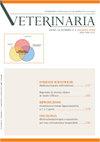体外发酵系统缓冲条件对瘤胃酸中毒研究的适应性
Q4 Veterinary
引用次数: 0
摘要
瘤胃酸中毒是牛生产中的一种重要疾病。适合其研究的体外技术的发展将允许降低成本和加快时间,以实现有用的结果,有助于提高产量,对动物福利的影响最小。在本研究中,采用不同缓冲溶液(人工唾液)对“体外气体”方法进行了改进,以评估其在模拟瘤胃酸中毒情况下的缓冲效果。连续进行了三次试验。首先测试了为需要高缓冲水平(SA01)的研究配制的人工唾液,验证了它不适合模拟酸中毒。然后研究了唾液SA01成分的五种变化,最后用不同的成分和加工方法对两种唾液进行了测试。采用Student 's t (α = 0.05)法比较了4次发酵(0、4、12和24h)与未触发模拟酸中毒的缓冲系统对照处理的pH演变差异,并将各处理的数值进行非线性回归,调整为递减对数模型,比较了发酵系统pH的变化差异。虽然在最后的实验中所研究的三种人工唾液都能达到预期的目的,但在酸中毒情况分析中表现最好的是碳酸氢盐含量较低、磷酸盐含量较高的人工唾液SA03。本文章由计算机程序翻译,如有差异,请以英文原文为准。
Adaptación de las condiciones de tamponamiento de un sistema de fermentación in vitro para el estudio de la acidosis ruminal
Ruminal acidosis is an important disease of cattle production. The development of in vitro techniques suitable for its study would allow to reduce costs and accelerate the times to achieve results useful to contribute to the increase of production, minimally affecting animal welfare. In the present study, a “gas in vitro” method was modified using different buffer solutions (artificial saliva) to assess their buffering effect in simulated ruminal acidosis situations. Three successive tests were carried out. An artificial saliva formulated for studies that required a high buffering level (SA01) was first tested, verifying that it was not appropriate for the simulation of acidosis. Five variations in the composition of saliva SA01 were then studied and finally two saliva were tested with a different composition and elaboration methods. Differences in the evolution of pH in the fermentation systems were studied through their comparison in four times of fermentation (0, 4, 12 and 24h) with control treatments with buffered systems without triggering the simulated acidosis by Student’s t (α = 0.05) and through the comparison of the parameters obtained by means of a non-linear regression of the values obtained from each treatment, adjusting it to a descending logarithmic model. Although the three artificial salivas studied in the last experiment could meet the sought objective, the artificial saliva SA03, with a lower amount of bicarbonate and higher proportion of phosphates, was the one that presented the best behavior for the analysis of acidosis situations.
求助全文
通过发布文献求助,成功后即可免费获取论文全文。
去求助
来源期刊

Veterinaria
农林科学-兽医学
CiteScore
0.10
自引率
0.00%
发文量
21
审稿时长
>12 weeks
期刊介绍:
VETERINARIA is the official scientific journal of the Italian Companion Animal Veterinary Association (SCIVAC) and is published bimonthly by Edizioni Veterinarie (E.V.). Its aim is to promote the spread and development of new ideas and techniques in the field of clinical and veterinary practices, with the ultimate goal of improving and promoting the continuing education of veterinary practicioners. VETERINARIA publishes literature reviews, original articles, diagnostic corners and clinical cases on different topics related to medicine and surgery of the dog, cat and of other companion animals, as well as short communications from congresses.
 求助内容:
求助内容: 应助结果提醒方式:
应助结果提醒方式:


